Peculiarities of Holmium and Iron Triad Ions Co-Reduction: Formation of HoxNiy (HoxCoy, HoxFey) Intermetallic Compounds in Chloride Melts
Abstract
:1. Introduction
2. Experimental Section
2.1. Electrochemical Cell and Electrodes
2.2. Analysis Methods and Cathode Deposits Diagnostics
2.3. Chemicals
2.4. Electrolyte Preparation
3. Results and Discussion
3.1. Electroreduction of Ho3+ Ions in the Equimolar KCl-NaCl Melt at 973 K
3.2. Co-Reduction of Ho3+ and Ni2+ Ions in the KCl-NaCl Equimolar Melt at 973 K
3.3. Co-Reduction of Ho3+ and Co2+ Ions in the Equimolar KCl-NaCl Melt at 973 K
3.4. Electrolytic Co-Reduction of Ho3+ and Fe3+ Ions in the Equimolar KCl-NaCl Melt at 973 K
4. Conclusions
5. Patents
Author Contributions
Funding
Institutional Review Board Statement
Informed Consent Statement
Data Availability Statement
Acknowledgments
Conflicts of Interest
References
- Il’yin, A.A.; Il’yin, A.P.; Kurochkin, V.Y. Study of the physicochemical properties of iron oxide catalysts promoted by lanthanides (Issledovaniye fisico-khimicheskikh svoistv zheleznooksidnykh catalyzatorov, promotirovannykh lantanoidov). Izv. Vyss. Uchebnykh Zaved. Seriya “Khimiya Khimicheskaya Tekhnologiya” 2010, 53, 90–93. (In Russian) [Google Scholar]
- Bushuyev, A.N.; Yelkin, O.V.; Tolstoborov, I.V.; Kondratiyev, D.A. Production of nickel-neodymium intermetallic compound in the equimolar NaCl-KCl melt (Polucheniye intermetallicheskogo soedineniya nickel-neodim v ekvimolnom rasplave NaCl-KCl). Adv. Sci. 2017, 2, 8. (In Russian) [Google Scholar]
- Ganchenkova, M.G.; Borodin, V.A.; Binyukova, S.Y.; Gonzalez, E.A.; Jasen, P.V.; Juan, A. Advanced materials for hydrogen storage based on iron-palladium intermetallic alloys. Inorg. Mater. Appl. Res. 2011, 2, 172–175. [Google Scholar] [CrossRef]
- Itin, V.I.; Nayborodenko, Y.S. High Temperature Synthesis of Intermetallic Compounds; Tomsk University Publishing: Tomsk, Russia, 1989; p. 161. (In Russian) [Google Scholar]
- Martin, D.L.; Elnora, N.Y. Nickel-Lanthanum Alloy Produced by a Reduction-Diffusion Process. U.S. Patent 3,918,933, 11 November 1975. [Google Scholar]
- Martin, D.L.; Elnora, N.Y. Nickel-Lanthanum Alloy Produced by a Reduction-Diffusion Process. U.S. Patent 3,883,346, 13 May 1975. [Google Scholar]
- Kamarzin, A.A.; Osadchaja, L.I.; Podojnitsyn, S.V.; Stonoga, Y.A.; Zelenin, Y.M.; Bondin, V.V. Method of Preparing Composition for Hydrogen Accumulation. RU Patent 2,113,400, 20 June 1998. [Google Scholar]
- Kasimtsev, A.V. Method for Making Reversible Hydrogen-Sorbing Alloy Combination. RU Patent 2,351,534, 10 April 2009. [Google Scholar]
- Shapoval, V.I.; Malyshev, V.V.; Novoselova, I.A.; Kushkhov, K.B. Modern problems in the high-temperature electrochemical synthesis of the compounds of Group IV–VI transition metals. Russ. Chem. Rev. 1995, 64, 125–132. [Google Scholar] [CrossRef]
- Kushkhov, K.B.; Tlenkopachev, M.R. Electrochemical Synthesis of Intermetallic and Refractory Compounds Based on Rare-Earth Metals in Ionic Melts: Achievements and Prospects. Russ. J. Gen. Chem. 2021, 91, 251–272. [Google Scholar] [CrossRef]
- Qiqin, Y. Electrochemistry of deposition of rare earth metals and their alloys in molten salts. In Proceedings of the 6th International Symposium on Molten Salt Chemistry and Technology, Shanghai, China, 8–13 October 2001; pp. 383–390. [Google Scholar]
- Su, Y.Z.; Yang, Q.Q.; Liu, G.K. Electroreduction of Ho3+ on nickel cathode in molten KCl-HoCl3. J. Rare Earths 2000, 18, 34–38. [Google Scholar]
- Yang, Q.Q.; Liu, G.K.; Su, Y.Z. Electroreduction of Holmium ion on iron electrode in molten chlorides. J. Electrochem. 1995, 1, 44–49. (In Chinese) [Google Scholar]
- Mamantov, M.; Manning, D.L.; Dale, J.M. Reversible deposition of metals on solid electrodes by voltammetry with linearyvaring potential. J. Electroanal. Chem. 1965, 9, 253–259. [Google Scholar]
- Kabanov, B.N.; Astakhov, I.I.; Kiseleva, I.G. Formation of crystalline intermetallic compounds and solid solutions in electrochemical incorporation of metals into cathodes. Electrochim. Acta 1979, 24, 167–171. [Google Scholar] [CrossRef]
- Vindizheva, M.K.; Mukozheva, R.A.; Tlenkopachev, M.R.; Kushkhov, K.B. Electrochemical synthsis of intermetallics based on samarium and cobalt in ionic melts (Elecktrokhimicheskiy syntez intermetallidov na osnove smamriya y cobalt v ionnykh rasplavakh). Perspect. Mater. 2010, 9, 255–257. (In Russian) [Google Scholar]
- Kushkhov, K.B.; Vindizheva, M.K.; Mukozheva, R.A.; Kalibatova, M.N. Electrochemical synthesis of disperse lanthanum boride powders from halide melts (Electrokhimicheskiy sintez dispersnykh poroshkov boridnykh faz lantana iz galoguenidnikh rasplavov). Izv. Vyss. Ychebnykh Zavedeniy. Poroshkovaya Metall. Functsionalniye Pokrytiya 2014, 2, 11–16. (In Russian) [Google Scholar]
- Kushkhov, K.B.; Vindizheva, M.K.; Mukozheva, R.A.; Abazova, A.K.; Kyarova, Z.K. Investigation of the mechanism of zerium and fluoroborate ions electroreduction on the tungsten cathode and synthesis of their compounds in the K, Na, Cs/Cl eutectics at 873 K. Izv. Kabard.-Balk. Gos. Univ. 2016, 6, 52–59. (In Russian) [Google Scholar]
- Liu, L.; Tong, Y.; Yang, Q. Electroreduction Co(II), Ni(II), and codeposition with La(III) in in urea-NaBr melt. Rare Metals 2000, 19, 237–241. [Google Scholar]
- Kushkhov, K.B.; Kardanova, R.A. Electrochemical Method for Holmium and Nickel Intermetallic Compounds Nanopowders Production in Halide Melts. RU Patent 2621508C2, 6 June 2017. [Google Scholar]
- Su, L.L.; Liu, K.; Liu, Y.L.; Wang, L.; Yuan, L.Y.; Wang, L.; Li, Z.J.; Zhao, X.L.; Chai, Z.F.; Shi, W.Q. Electrochemical behaviors of Dy(III) and its co-reduction with Al(III) in molten LiCl−KCl salts. Electrochim. Acta 2014, 147, 87–95. [Google Scholar] [CrossRef]
- Kushkhov, K.; Ali, Z.; Khotov, A.; Kholkina, A. Mechanism of Dy3+ and Nd3+ Ions Electrochemical Coreduction with Ni2+, Co2+, and Fe3+ Ions in Chloride Melts. Materials 2021, 14, 7440. [Google Scholar] [CrossRef] [PubMed]
- Liu, K.; Liu, Y.L.; Yuan, L.Y.; Wang, L.; Li, Z.J.; Chai, Z.F.; Shi, W.Q. Thermodynamic and electrochemical properties of holmium and HoxAly intermetallic compounds in the LiCl−KCl eutectic. Electrochim. Acta 2015, 174, 15–25. [Google Scholar] [CrossRef]
- Castrillejo, Y.; Bermejo, M.R.; Barrado, E.; Medina, J.; Martinez, M. Electrodeposition of Ho and Electrochemical Formation of Ho-Al Alloys from the Eutectic LiCl–KCl. J. Electrochem. Soc. 2006, 153, 713–721. [Google Scholar] [CrossRef]
- Yin, T.-Q.; Xue, Y.; Yan, Y.; Ma, Z.C.; Ma, F.-Q.; Zhang, M.-L.; Wang, G.-L.; Qiu, M. Recovery and separation of rare earth elements by molten salt electrolysis. Int. J. Miner. Metall. Mater. 2021, 28, 899–914. [Google Scholar]
- Chernova, O.V.; Zhukovin, S.V.; Kondrat’ev, D.A. Electroreduction of Holmium Chloride in the Equimolar NaCl–KCl Melt. Russ. Metall. 2020, 102–106. [Google Scholar]
- Volkov, S.V.; Grishenko, V.F.; Delimarskyi, Y.K. Coordination Chemistry of Molten Melts (Koordinatsionnaya Khimiya Solevykh Rasplavov); Naukova Dumka: Kiev, Ukraine, 1977; 332p. [Google Scholar]
- Sytchev, J.; Kushkhov, H.; Sychev, J. Voltammetric investigation of the reduction processes of nickel cobalt and iron ions in chloride and chloro–fluoride melts. In Proceedings of the International Computer Science Conference, Miskolc, Hungary, 22–24 February 2000. [Google Scholar]
- Kushkhov, H.B.; Supatashvili, D.G.; Shapoval, V.I.; Novoselova, I.A.; Gasviana, N.A. Co-reduction of molybdate ion with Ni and Co cations in chloride melts (Sovmestnoye electrovosstanovleniye molybdat iona s cationami Ni y Co v khloridnykh rasplavakh). Elektrokhimiya 1990, 26, 300–304. (In Russian) [Google Scholar]
- Lyakisheva, N.M. Phase Diagrams of Double Metallic Systems: Reference Book (Diagramma Sostoyaniy Dvoinykh Metallicheskihk System: Spravochnik); Book 1; Mashinostroyeniye: Moskva, Russia, 1999; Volume 3. (In Russian) [Google Scholar]
- Gladyshevskiy, Y.I.; Bodak, O.I. Crystalline Chemistry of Rare-Earth Metals Intermetallic Compounds (Crystallokhimiya Intermetallicheskikh Soedineniy Redkozemelnykh Metallov); Vysshaya Shkola: Lvov, Ukraine, 1982. (In Russian) [Google Scholar]
- Kubaschewski von Goldbeck, O. Iron—Binary Phase Diagrams; Springer: Berlin/Heidelberg, Germany, 1982. [Google Scholar]
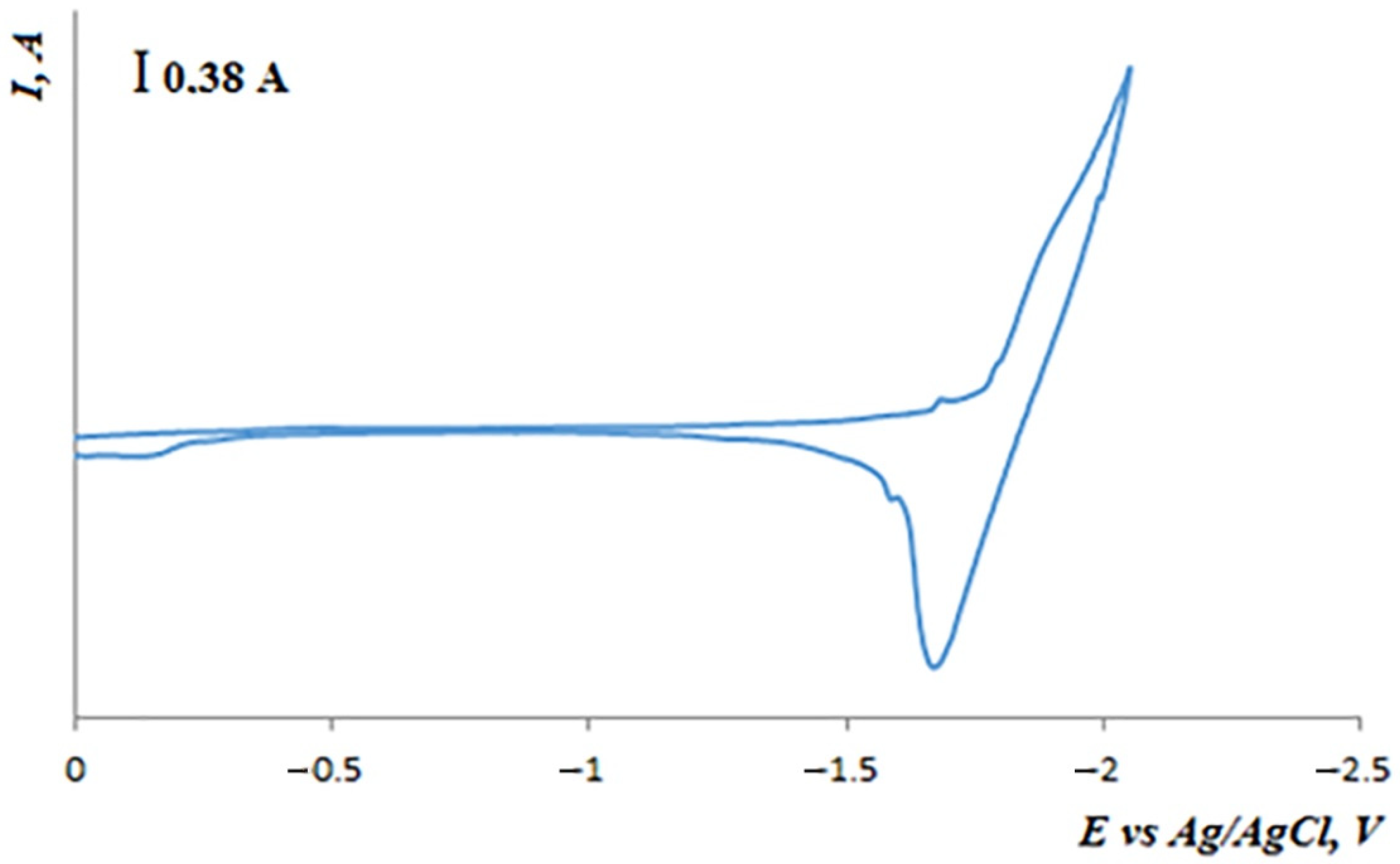
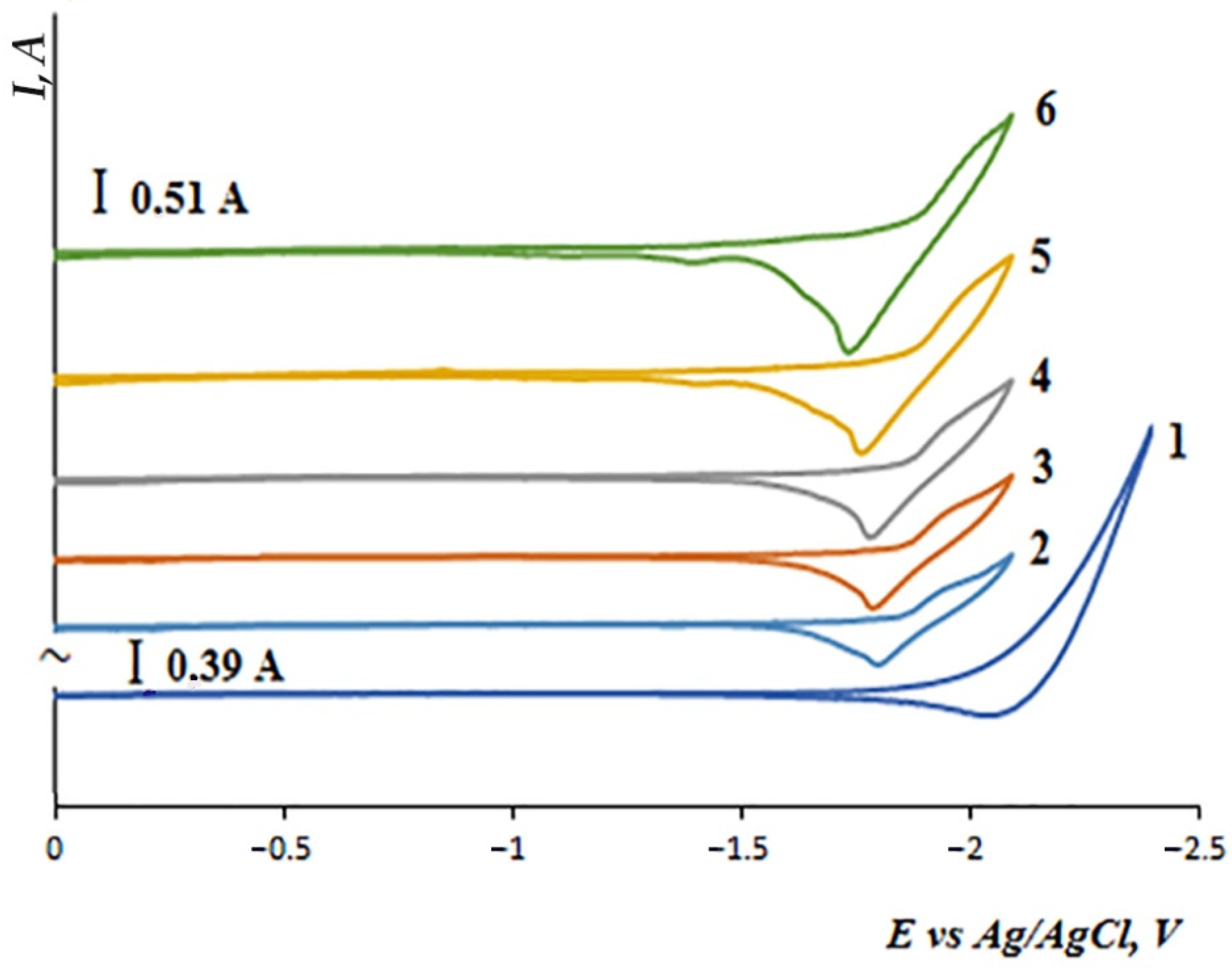
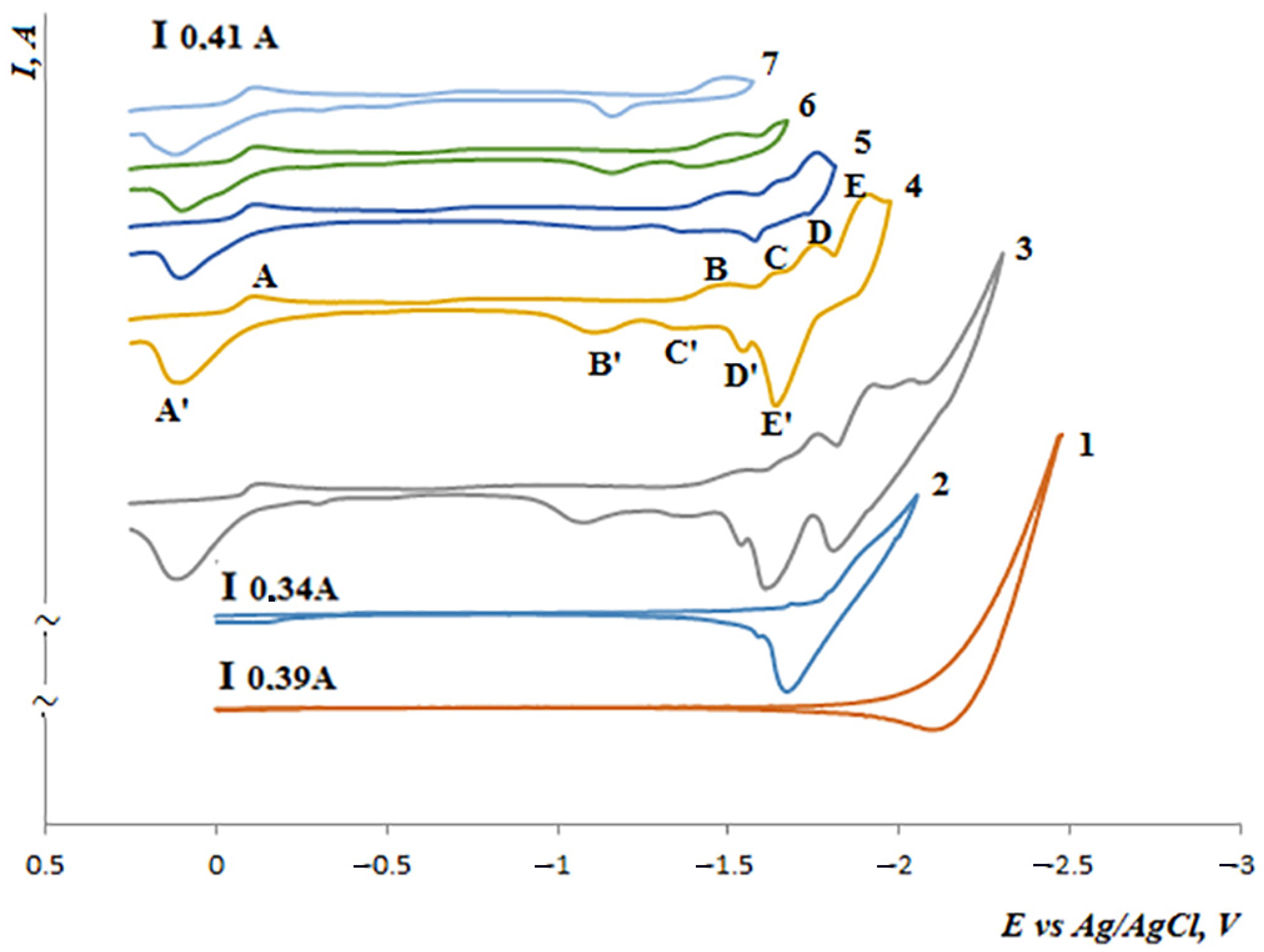
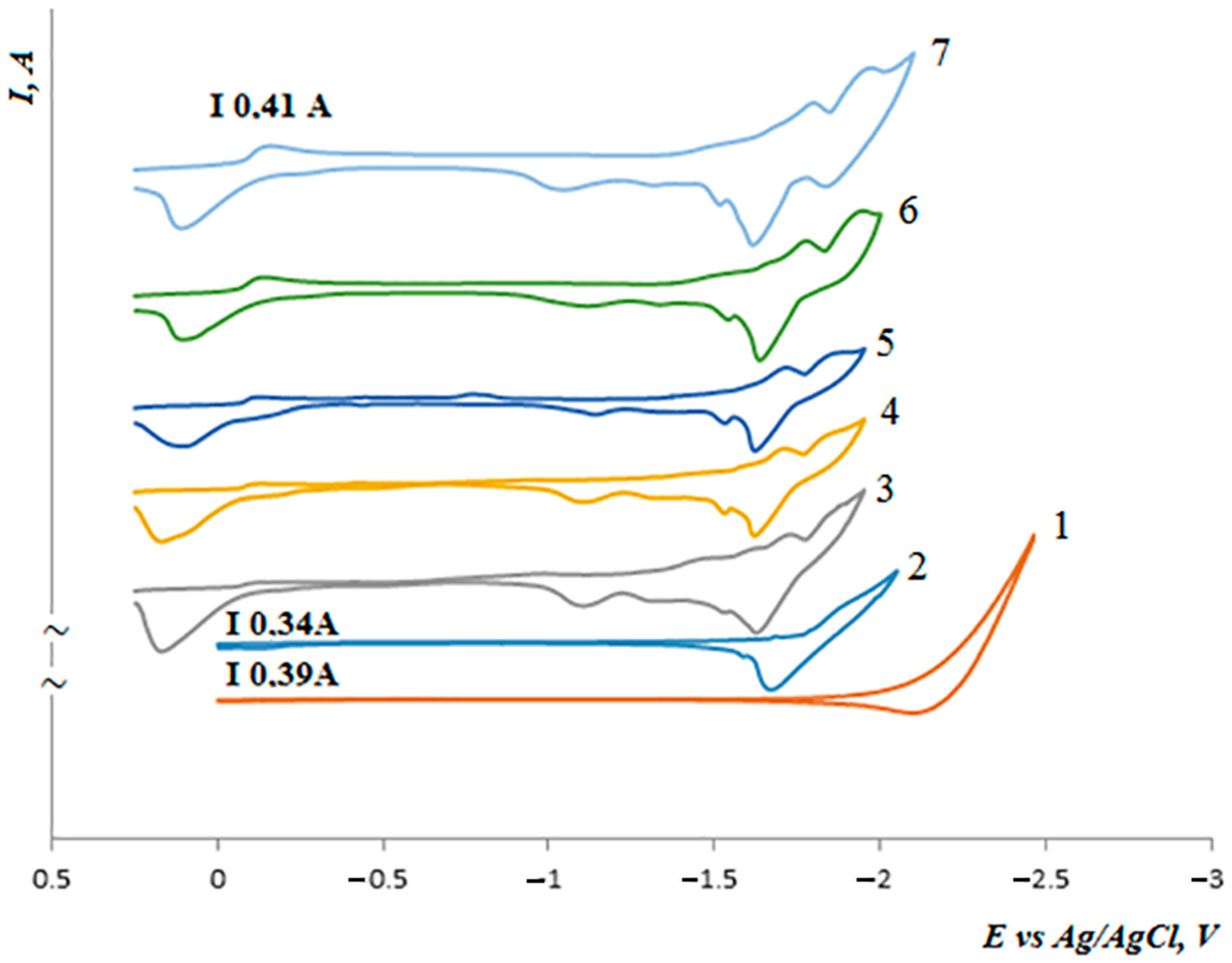

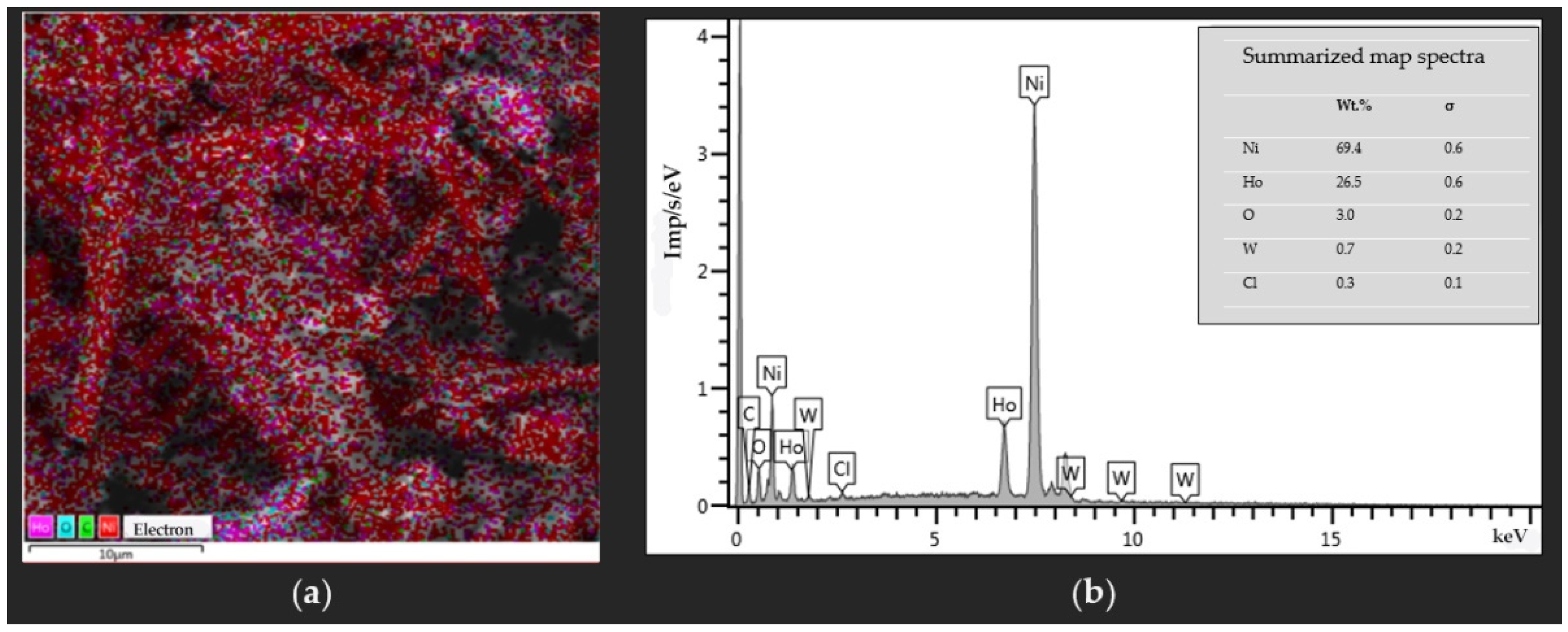

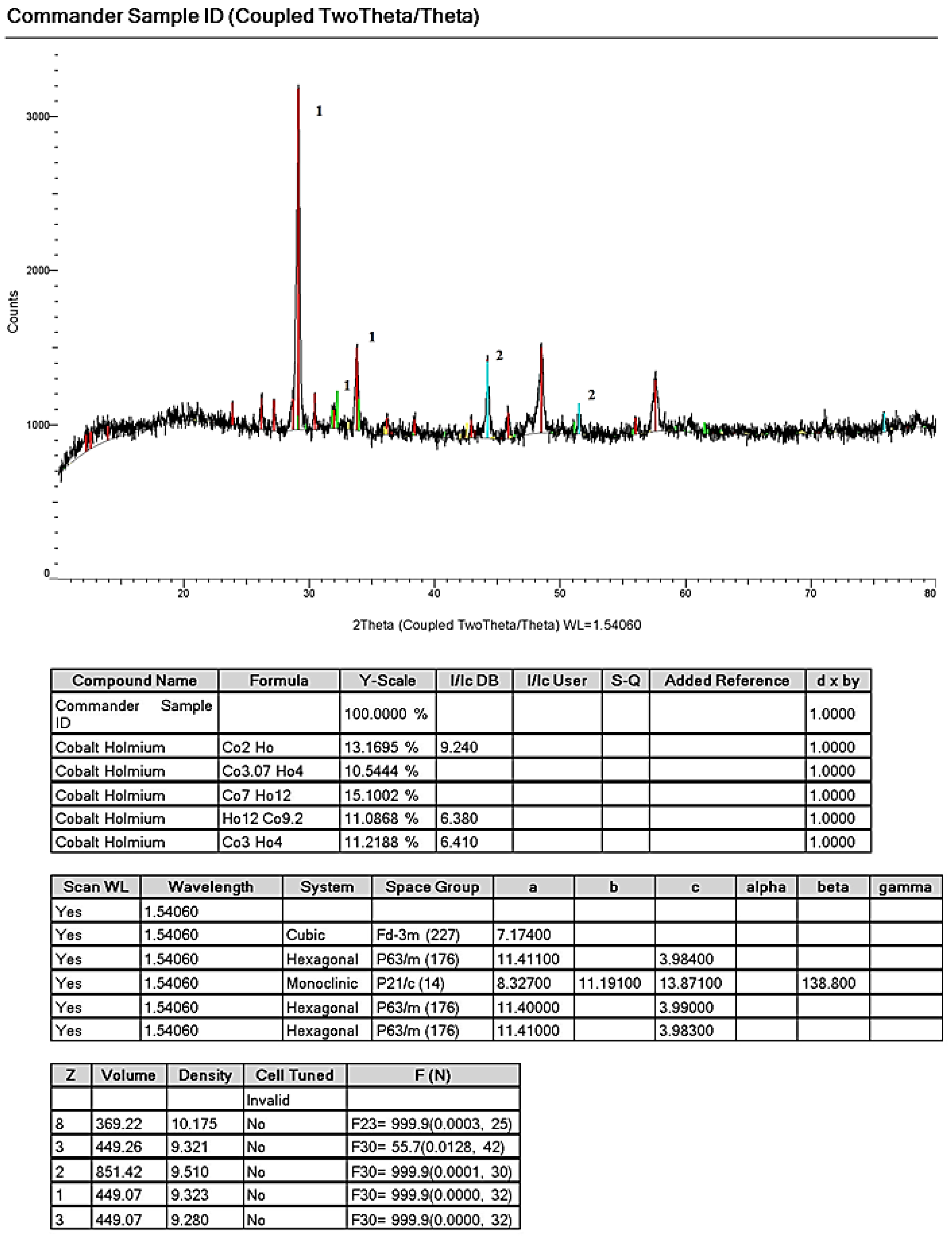


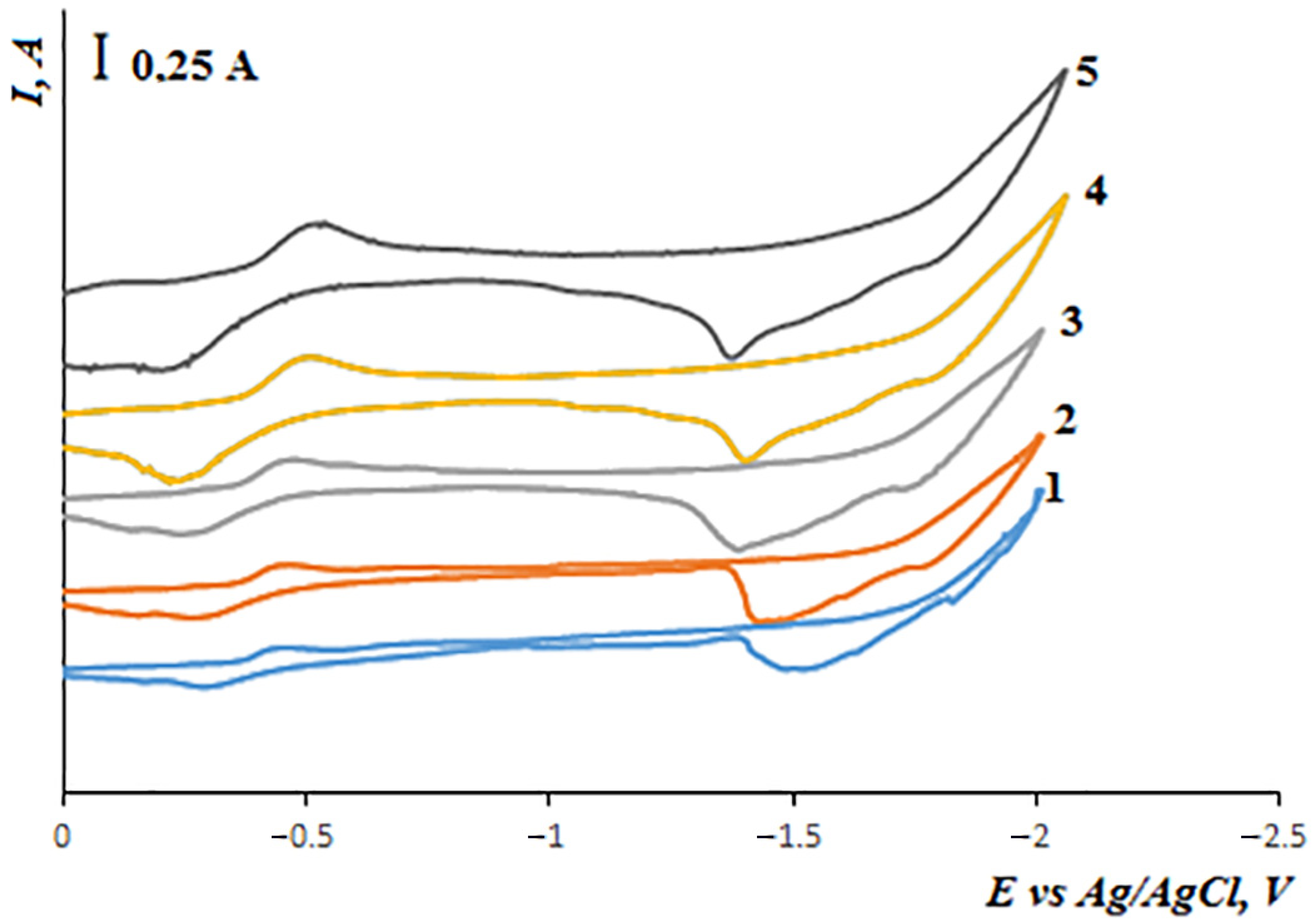
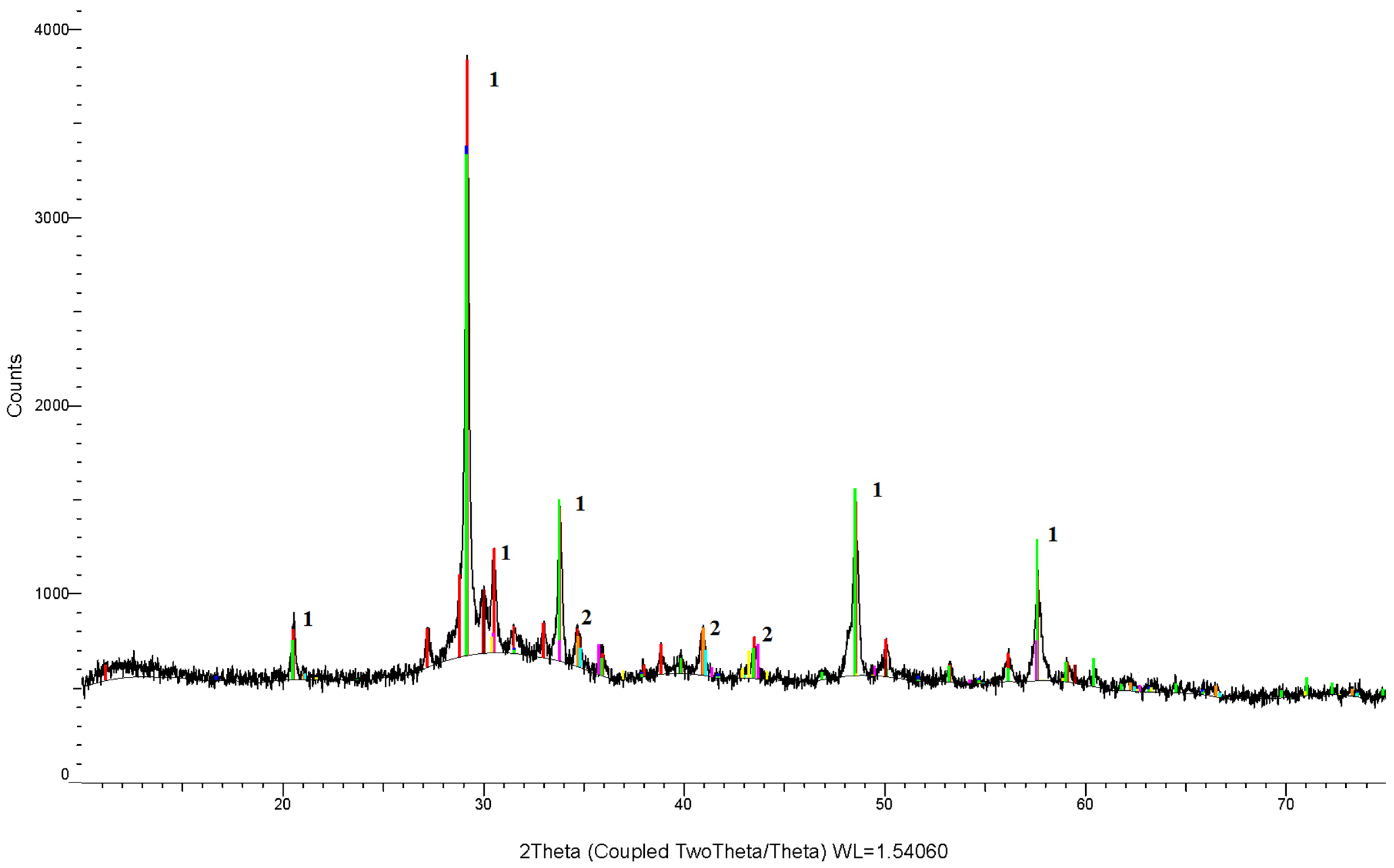
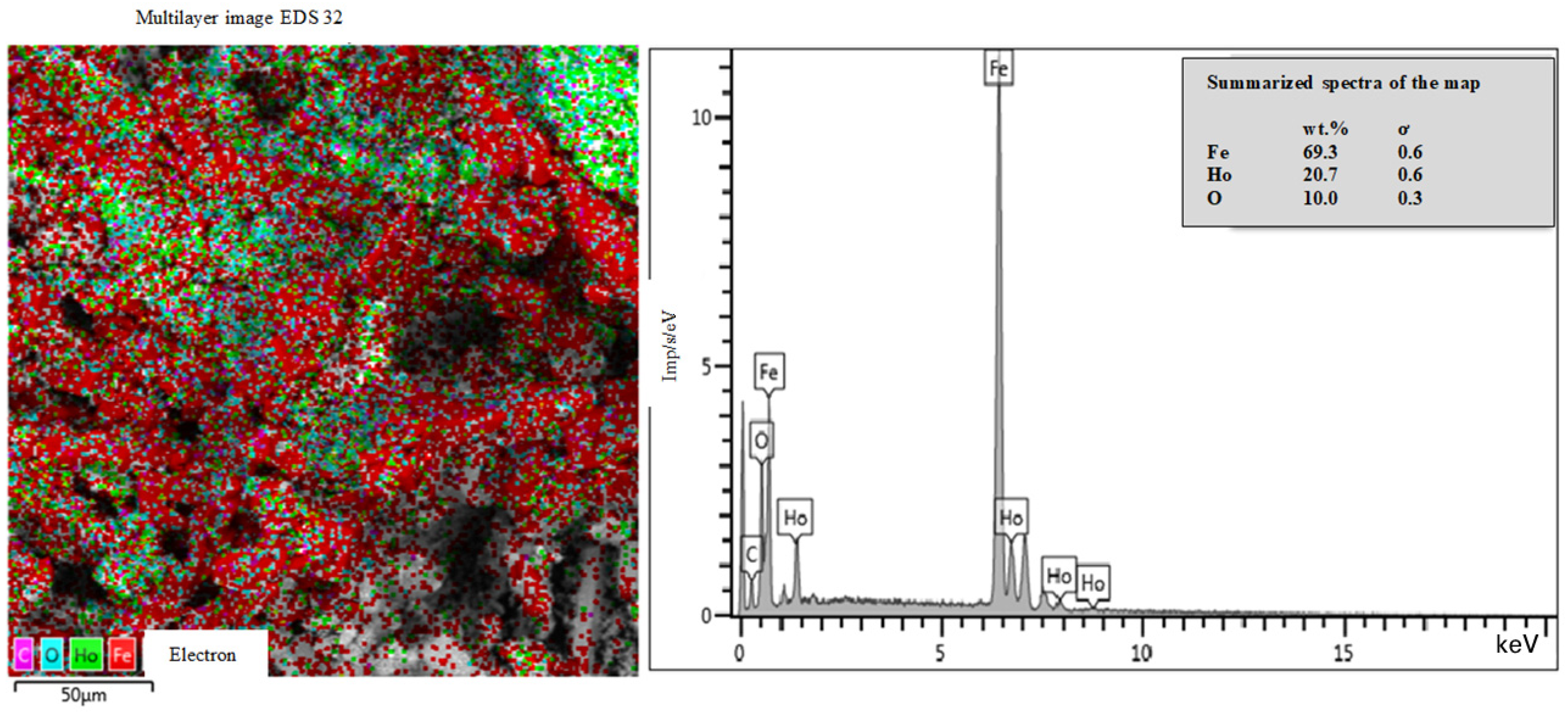
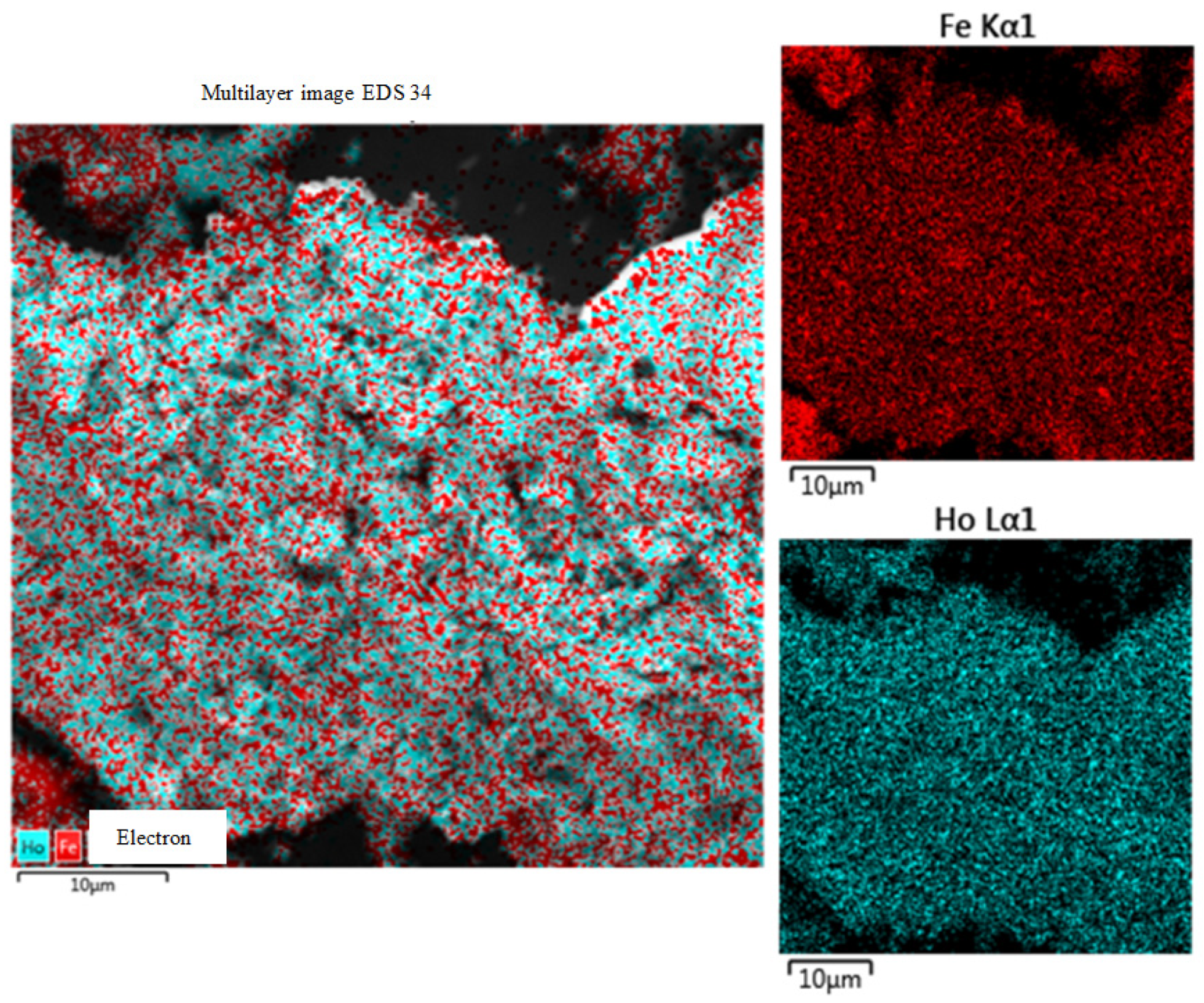
| V, V/s | Ip, A/cm2 | −Ep, V | −Ep/2, V | ΔE, V | ||
|---|---|---|---|---|---|---|
| C1(HoCl3) = 0.5 mol.% | ||||||
| 0.5 | 0.374 | 0.529 | 2.067 | 2.002 | 0.065 | 2.83 |
| 0.2 | 0.165 | 0.369 | 2.054 | 1.992 | 0.062 | 2.97 |
| 0.1 | 0.125 | 0.394 | 2.043 | 1.977 | 0.066 | 2.79 |
| 0.05 | 0.110 | 0.494 | 2.036 | 1.973 | 0.063 | 2.93 |
| C2(HoCl3) = 1.0 mol.% | ||||||
| 1.0 | 0.539 | 0.539 | 2.040 | 1.978 | 0.062 | 2.97 |
| 0.5 | 0.443 | 0.626 | 2.029 | 1.967 | 0.062 | 2.97 |
| 0.2 | 0.323 | 0.723 | 2.011 | 1.950 | 0.061 | 3.02 |
| 0.1 | 0.264 | 0.834 | 2.003 | 1.945 | 0.058 | 3.17 |
| 0.05 | 0.201 | 0.900 | 1.996 | 1.930 | 0.066 | 2.79 |
| C2(HoCl3) = 1.5 mol.% | ||||||
| 0.5 | 0.612 | 0.865 | 1.908 | 1.842 | 0.066 | 2.79 |
| 0.2 | 0.425 | 0.950 | 1.901 | 1.838 | 0.063 | 2.93 |
| 0.1 | 0.355 | 1.121 | 1.890 | 1.827 | 0.063 | 2.93 |
| 0.05 | 0.279 | 1.249 | 1.871 | 1.812 | 0.059 | 3.12 |
| No. | C (NiCl2) mol.% | C (HoCl3) mol.% | c(Ni):c(Ho) | Phase Composition | Volume Fraction of Particles up to 100 nm | Product Yield g/A·h |
|---|---|---|---|---|---|---|
| 1 | 0.5 | 0.5 | 1:1 | Ni, HoNi, HoNi5, HoNi3 | 22% | 0.36 |
| 2 | 0.5 | 1.0 | 1:2 | HoNi, HoNi5, Ni, HoNi3 | 31% | 0.56 |
| 3 | 0.5 | 1.5 | 1:3 | HoNi, HoNi5, Ni, HoNi3 | 28% | 0.67 |
| 4 | 0.5 | 2.0 | 1:4 | HoNi, HoNi5, Ni, HoNi3 | 51% | 0.82 |
| 5 | 0.5 | 2.5 | 1:5 | HoNi, HoNi5, HoNi3 | 69% | 0.92 |
| 6 | 1.0 | 0.5 | 2:1 | Ni, HoNi, HoNi3 | 37% | 0.49 |
| No. | C (CoCl2), mol.% | C (HoCl3), mol.% | c (Co):c(Ho) | Phase Composition |
|---|---|---|---|---|
| 1 | 0.5 | 0.5 | 1:1 | Co, HoCo2 |
| 2 | 0.5 | 1.0 | 1:2 | Co, HoCo2 |
| 3 | 0.5 | 1.5 | 1:3 | Co, HoCo5, HoCo3 |
| 4 | 0.5 | 2.0 | 1:4 | Ho2Co17 |
| 5 | 0.5 | 2.5 | 1:5 | Ho, Ho2Co17 |
| 6 | 1.0 | 0.5 | 2:1 | Co, HoCo5 |
| 7 | 1.5 | 0.5 | 3:1 | Co, Ho2Co17 |
| 8 | 2.0 | 0.5 | 4:1 | Co, Ho, Ho2Co17 |
Publisher’s Note: MDPI stays neutral with regard to jurisdictional claims in published maps and institutional affiliations. |
© 2022 by the authors. Licensee MDPI, Basel, Switzerland. This article is an open access article distributed under the terms and conditions of the Creative Commons Attribution (CC BY) license (https://creativecommons.org/licenses/by/4.0/).
Share and Cite
Kushkhov, K.; Kardanova, R.; Kholkina, A. Peculiarities of Holmium and Iron Triad Ions Co-Reduction: Formation of HoxNiy (HoxCoy, HoxFey) Intermetallic Compounds in Chloride Melts. Processes 2022, 10, 1723. https://doi.org/10.3390/pr10091723
Kushkhov K, Kardanova R, Kholkina A. Peculiarities of Holmium and Iron Triad Ions Co-Reduction: Formation of HoxNiy (HoxCoy, HoxFey) Intermetallic Compounds in Chloride Melts. Processes. 2022; 10(9):1723. https://doi.org/10.3390/pr10091723
Chicago/Turabian StyleKushkhov, Khasbi, Ranetta Kardanova, and Anna Kholkina. 2022. "Peculiarities of Holmium and Iron Triad Ions Co-Reduction: Formation of HoxNiy (HoxCoy, HoxFey) Intermetallic Compounds in Chloride Melts" Processes 10, no. 9: 1723. https://doi.org/10.3390/pr10091723
APA StyleKushkhov, K., Kardanova, R., & Kholkina, A. (2022). Peculiarities of Holmium and Iron Triad Ions Co-Reduction: Formation of HoxNiy (HoxCoy, HoxFey) Intermetallic Compounds in Chloride Melts. Processes, 10(9), 1723. https://doi.org/10.3390/pr10091723






